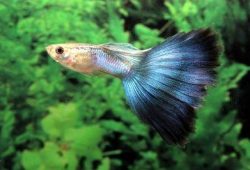Rare and Exotic Anthias
In the article I share what I learned about Rare and Exotic Anthias. While these two incredible species are best left to the experts, given the right environment, they can thrive in the marine aquarium.

For many people, Anthias are synonymous with the tropical reef, but for aquarists, they are often synonymous with “hard-to-keep.” The anthias species discussed here are no exception. These are some of the rarest, most beautiful and difficult to keep anthias in the hobby. They are expert-only fishes, but with the proper skills, equipment and some luck, these fishes can be fantastic specimens for a reef tank.
Because Anthias species are hermaphroditic and sexually dimorphic (they change sexes and the sexes have different coloration), there is often a price difference between males and females. Males are usually more desirable and more expensive. It is best to keep these fishes in shoals of one male and eight to ten females in large, mature reef tanks. They should be provided with zooplankton food (e.g. mysis shrimp, vitamin-enriched brine shrimp, etc.) and floating herbivorous foods. Feed in small amounts at least three to four times per day.
Contents
The Venralis Anthias (Pseudanthias ventralis)
The Ventralis Anthias, sometimes called the Longfin Anthias or Rainbow Fairy Basslet, is one of the more sought after anthias species and also one of the more difficult to keep. This fish seldom exceeds three inches in length and comes from the Western Pacific (frequently collected from the Cook Islands). The Venralis Anthias is replaced by Pseudanthias hawaiiensis in Hawaii and the Johnston Islands.
While it is a relatively small fish, it does best in a mature aquarium of 70 gallons or larger. If you plan to have more than one in the same tank, be sure to keep only one male with at least eight females. A single male may be kept in a smaller system (30+ gallons) if it is a mature system and the fish’s dietary needs are met with a frequent feeding.
The Ventralis Anthias is a deep water species of anthias and prefers a dimly lit aquarium. In the wild, it is a secretive fish that inhabits caves and coral rubble along steep drop-offs (down to over 350 feet). As such, a slow acclimatization to bright lights is necessary; plan on it taking at least a couple weeks. This fish will do fine with other peaceful tankmates but will probably remain somewhat cryptic.
Both LiveAquaria and Blue Zoo Aquatics frequently have this fish in stock. At the time of this writing, LiveAquaria charges $69.99 for a female and $79.99 for a male. Blue Zoo Aquatics sells females for $64.95 and males for $69.95. While less expensive, Blue Zoo Aquatics does not offer their standard guarantee on this species. LiveAquaria does.
Bimaculatus Anthias (Pseudanthias bimaculatus)
This anthias species, sometimes called the Two-Spot Anthias or Two Spotted Basslet, may approach six inches in length in the home aquarium, although it usually stays closer to five. From the Indo-Pacific (often collected from Tonga), this is an attractive fish that needs at least a 70-gallon aquarium. Some aquarists think this is the most attractive anthias, and it can be kept in shoals with one male and eight or more females.
This is a somewhat more aggressive anthias and may act territorial or harass other mid-water planktivores. In the wild, it inhabits deep coastal drop-offs down to 180 feet and may need to be gradually acclimated to high intensity reef lighting. The Bimaculatus Anthias is closely related to P. pleurotaenia and is known to produce accidental hybrids in the wild.
At the time of this writing, LiveAquaria sells female Bimaculatus Anthias for $69.99 and males for $79.99. Blue Zoo Aquatics sells medium sized females for $68.95 and large males for $79.95. Blue Zoo Aquatics also often carries extra-large males for $84.95, but they do not offer their standard livestock guarantee on this species. LiveAquaria does.
Not ready for the expert-only anthias species? Here are a few species of anthias appropriate for the intermediate aquarist.



